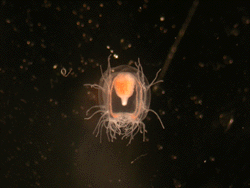Invasion History
First Non-native North American Tidal Record: 1970First Non-native West Coast Tidal Record: 1970
First Non-native East/Gulf Coast Tidal Record:
General Invasion History:
Climacocodon ikarii is a remarkable, completely planktonic hydrozoan, first described from Oshoro, Hokkaido, on the Sea of Japan, and later collected from Muroran and Akkeshi on the Pacific coast of Hokkaido (Kubota 1979). This hydrozoan, although planktonic, appears to be confined to coastal waters, and has not been collected in the open ocean (T. Uchida 1970, in a letter to DeBoyd L. Smith, James T. Carlton, personal communication). It has been 'occasionally' collected off Central California and Coos Bay, Oregon.
North American Invasion History:
Invasion History on the West Coast:
Climacocodon ikarii was first collected in 1970 off a wharf in Santa Cruz, California by DeBoyd L. Smith, and illustrated in a book on plankton identification (Smith 1977). Several more specimens were collected off Dillon Beach, Tomales Bay (D. L. Smith, 1987, personal communication to James T. Carlton). This species was also collected and photographed in 2002 from Coos Bay, OR (R. Emlet, personal communication to James T. Carlton 2010). The photograph was published in Mills et al. (in Carlton 2007; plate 42I, page 138). This hydrozoan was probably introduced in ballast water.
Description
Climacocodon ikarii is a hydrozoan whose polyp and medusa forms are both planktonic (Smith 1977; Kubota 1979; Mills et al., in Carlton 2007). Polyps, when first released, are very small (0.4-0.5 mm) and shaped like a truncated cone, with three circlets of short, blunt tentacles radiating outwards. As the polyp grows, the hypostome becomes elongated and the oral tentacles are well-separated from the two circlets of aboral tentacles. A second whorl of blunt oral tentacles develops above the first. Medusa buds are produced around the base of the hypostome. Mature polyps are 1.6-2.3 mm long, and resemble the detached hydranth of a benthic hydroid, though the tentacles remain short and blunt, and the base of the hypostome is surrounded by medusa-buds.
The medusa of C. ikarii is between cubical and ovoid in shape, and when mature, a little taller than wide. In young medusae, the manubrium is cylindrical, but it becomes flask-shaped as the medusa grows. When extended, it can reach to the opening of the bell cavity. The middle of the manubrium is surrounded by gonadal tissue. In females, clusters of eggs develop on the manubrium. There are four radial canals, which form swellings when they join the ring canal. The velum is well-developed. A unique feature of C. ikarii is the presence of tentacles arising from the middle sides of the umbrella as well as from the margin. Four sets of about eight tentacles project from the radial canals, three of these from the sides of the bell. Depending on maturity of the medusae, the total number of tentacles varies from about 23 to 46. Mature medusae are about 3 mm in height (description from: Kubota 1979).
Taxonomy
Taxonomic Tree
| Kingdom: | Animalia | |
| Phylum: | Cnidaria | |
| Class: | Hydrozoa | |
| Subclass: | Hydroidolina | |
| Order: | Anthoathecatae | |
| Suborder: | Capitata | |
| Family: | Margelopsidae | |
| Genus: | Climacocodon | |
| Species: | ikarii |
Synonyms
Potentially Misidentified Species
Ecology
General:
Climacocodon ikarii is a hydrozoan whose polyp and medusa forms are both planktonic. The polyp drifts in the plankton, and buds off medusae as it grows (Smith 1977; Kubota 1979; Mills et al., in Carlton 2007). Presumably, the polyp captures zooplankton, although its tentacles are short and blunt. The medusa also feeds on zooplankton and develops eggs in its ovaries. When fertilized, these eggs develop into planulae, which develop into polyps. Kubota (1979) described the development of this organism from preserved specimens. To our knowledge, C. ikarii has not been reared, so many details of its life history are unknown.
Food:
zooplankton
Trophic Status:
Suspension Feeder
SusFedHabitats
| General Habitat | Unstructured Bottom | None |
| Salinity Range | Polyhaline | 18-30 PSU |
| Salinity Range | Euhaline | 30-40 PSU |
| Tidal Range | Subtidal | None |
| Vertical Habitat | Planktonic | None |
Tolerances and Life History Parameters
| Maximum Width (mm) | 3 | Medusa diameter (Kubota 1979) |
| Broad Temperature Range | None | Cold-temperate |
| Broad Salinity Range | None | Polyhaline-Euhaline |
General Impacts
No impacts have been reported for native or introduced populations of Climacocodon ikarii.Regional Distribution Map
Non-native
Native
Cryptogenic
Failed
| Bioregion | Region Name | Year | Invasion Status | Population Status |
|---|---|---|---|---|
| NEP-V | Northern California to Mid Channel Islands | 1970 | Non-native | Established |
| P080 | Monterey Bay | 1970 | Non-native | Established |
| P110 | Tomales Bay | 1976 | Non-native | Established |
| NEP-IV | Puget Sound to Northern California | 2002 | Non-native | Established |
| P170 | Coos Bay | 2002 | Non-native | Established |
| NWP-4a | None | 1924 | Native | Established |
| NWP-4b | None | 0 | Native | Established |
Occurrence Map
| OCC_ID | Author | Year | Date | Locality | Status | Latitude | Longitude |
|---|
References
Carlton, James T. (Ed.) (2007) The Light and Smith Manual: Intertidal Invertebrates from Central California to Oregon Fourth Edition, Completely Revised and Expanded, University of California Press, Berkeley. Pp. <missing location>Kubota, Shin (1979) Morphological notes on the polyp and medusa of Climacocodon ikarii Uchida (Hydrozoa, Margelopsidae) in Hokkaido, Journal of the Faculty of Science, Hokkaido University, Series VI 22(1): 122-139
Mills, Claudia; Marques, Antonio; Migotto, Alvaro E; Calder, Dale R.; Hand, Cadet (2007) The Light and Smith Manual: Intertidal invertebrates from Central California to Oregon (4th edition), University of California Press, Berkeley CA. Pp. 118-168
Smith, DeBoyd L. (1977) <missing title>, Kendall/Hunt Publishing Company, Dubuque, Iowa. Pp. <missing location>
